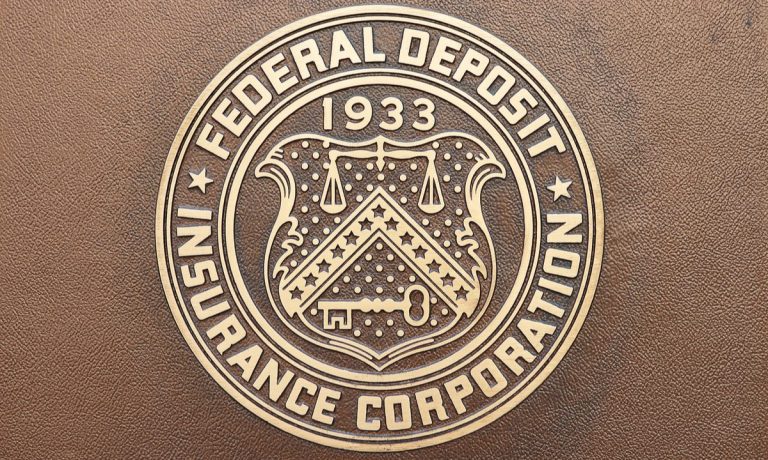
In the spring, two formerly obscure acronyms, SVB and FDIC, became household names.
That’s because after SVB (Silicon Valley Bank) collapsed due to a structurally weakened balance sheet, compounded by a panic-induced bank run, it entered into an FDIC (Federal Deposit Insurance Corporation) receivership along with two of its regional peers, Signature Bank and Silvergate Bank.
The FDIC ended up selling the bulk of what remained of SVB to First Citizens Bank March 27, more than two weeks after the former’s collapse March 10. But the mini-crisis sent long-tail tremors throughout the broader banking ecosystem and spurred calls for policy-led action.
The FDIC’s Board of Directors met Tuesday (Aug. 29) to discuss a Notice of Proposed Rulemaking (NPR) jointly with the Board of Governors of the Federal Reserve System (the Fed) and the Office of the Comptroller of the Currency (OCC) to require insured depository institutions with more than $100 billion in assets to maintain a minimum amount of long-term debt.
“The failure earlier this year of three large regional banks only underscored the agencies’ urgency in considering whether to put forward such a proposal,” FDIC Chairman Martin J. Gruenberg said in a statement.
“[A] long-term debt requirement such as the one being proposed today can mitigate the resolution challenges encountered in the failure of large regional banks and bolster financial stability,” Gruenberg added.
Under the proposal, regional banks would need to issue around $70 billion in new debt.
FDIC Vice Chairman Travis Hill indicated in a separate statement that he plans to “vote in favor” of the long-term debt proposal, despite adding that he “would have approached aspects of the proposal differently.”
The federal bank regulatory agencies are inviting public comment on the proposal. Comments are due by Nov. 30.
Read also: Regulators Blame Signature for Own Failure and Themselves for SVB’s
Certain observers have held that the decision to invoke the FDIC’s emergency powers after the collapse of SVB and Signature Bank — and later, First Republic Bank in May — was an admission that despite over a decade of costly reforms, the United States banking system is still absent an effective framework for resolving failed banks.
The failures of SVB and Signature resulted in a $15.8 billion bill, which is why the FDIC wants to make midsize lenders outline the details of how they would be dissolved in case of a failure.
The FDIC plans to extract a special assessment of extra fees from 113 larger banks over two years to recoup up to 95% of its losses after the rescues. The collections will begin in early 2024.
The new rules being proposed by the banking regulators are meant to ensure that banks’ long-term debt absorbs losses before the uninsured depositors and the FDIC take losses, which lowers the incentive for uninsured depositors to run.
“[E]ven if the institution fails, the buffer of long-term debt reduces cost to the Deposit Insurance Fund and makes it more likely that a closing weekend sale could comply with the statutory least-cost test and avoid the need for a systemic risk exception,” Gruenberg said.
Per its proponents, the FDIC proposal creates additional options in resolution, such as recapitalizing the failed bank under new ownership or breaking up the bank and selling portions of it to different acquirers, as an alternative to a merger with another large institution.
The thought is that having an established sale process, via what could be described as a living will, could serve as an effective way to limit the likelihood that one bank failure could lead to another.
FDIC regulators admitted during Tuesday’s meeting that the new long-term debt rule being proposed would compress banks’ net interest margin by three basis points, as well as marginally increase funding costs for banks.
U.S. banks have three years from the adoption of the new proposal’s rules to comply with them.
The rules would bring the regulatory requirements for banks like PNC Financial Services, Fifth Third Bancorp, Citizens Financial Group, and other lenders with over $100 billion in assets more in line with the oversight faced by some of the largest global banks, which already face their own debt requirement.
“These proposals attempt to fit regional and midsize banks into a regulatory mold designed for the largest globally active banks, a weakening of the bipartisan tailoring framework enacted by Congress,” wrote Bank Policy Institute President and CEO Greg Baer in a statement. “Regional banks have already developed credible resolution plans that reflect their structures, operations and risk profiles.”
In his own statement, Rob Nichols, head of the American Bankers Association, said the proposed rules “are another step in the wrong direction.”
“Today’s FDIC actions, in most cases over dissenting votes, come on top of last month’s misguided capital proposal and run counter to the bipartisan law Congress passed requiring that regulations be tailored based on a bank’s risk and business model,” he said. “We will advocate strongly to ensure that regulators understand the harm that these overly broad rules would impose on customers, communities and the banks that serve them.”